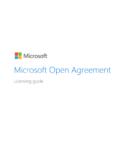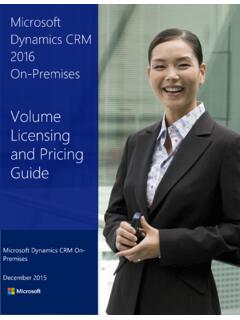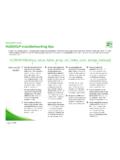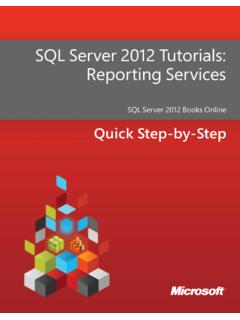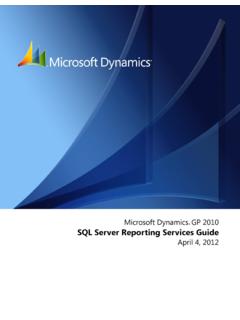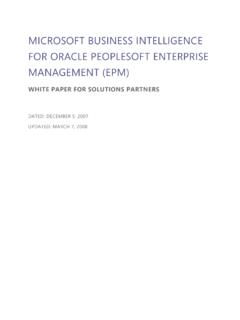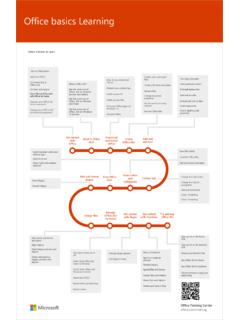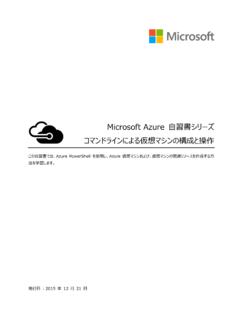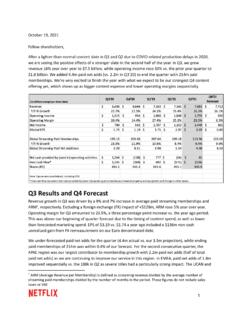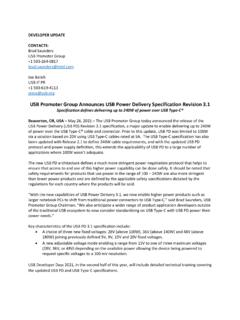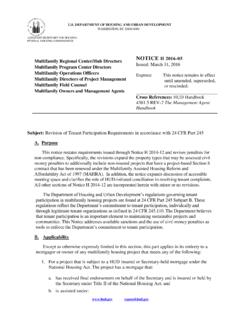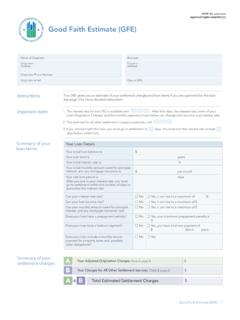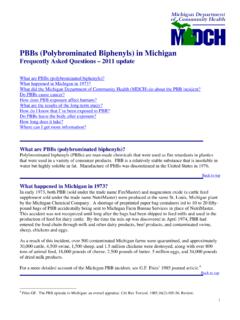Transcription of Microsoft Security Intelligence Report
1 Microsoft Security Intelligence Report Volume 13. January through June, 2012. Microsoft Security Intelligence Report This document is for informational purposes only. Microsoft MAKES NO. WARRANTIES, EXPRESS, IMPLIED, OR STATUTORY, AS TO THE. INFORMATION IN THIS DOCUMENT. This document is provided as-is. Information and views expressed in this document, including URL and other Internet Web site references, may change without notice. You bear the risk of using it. Copyright 2012 Microsoft Corporation. All rights reserved. Microsoft , the Microsoft logo, Active Directory, ActiveX, AppLocker, Bing, DirectX, Forefront, Hotmail, Internet Explorer, MSDN, Outlook, PowerPoint, the Security Shield logo, SQL Server, Visual Basic, Win32, Windows, Windows Media, Windows PowerShell, Windows Server, and Windows Vista are trademarks of the Microsoft group of companies.
2 The names of actual companies and products mentioned herein may be the trademarks of their respective owners. JANUARY JUNE 2012 i Authors Danielle Alyias Jeff Jones Tim Rains Microsoft Trustworthy Computing Microsoft Trustworthy Computing Microsoft Trustworthy Computing Dennis Batchelder Jimmy Kuo David Ross Microsoft Protection Technologies Microsoft Malware Protection Center Microsoft Trustworthy Computing Joe Blackbird Marc Lauricella David Seidman Microsoft Malware Protection Center Microsoft Trustworthy Computing Microsoft Trustworthy Computing Joe Faulhaber Jenn LeMond Weijuan Shi Davis Microsoft Malware Protection Center Microsoft IT Security and Risk Windows Business Group Management David Felstead Holly Stewart Bing Nam Ng Microsoft Malware Protection Center Microsoft Trustworthy Computing Roger A. Grimes Matt Thomlinson Microsoft IT Information Security Daryl Pecelj Microsoft Trustworthy Computing and Risk Management Microsoft IT Information Security and Risk Management Terry Zink Paul Henry Microsoft Exchange Online Protection Wadeware LLC Anthony Penta Microsoft Windows Safety Platform Contributors Doug Cavit Hideya Matsuda Mark Simos Microsoft Trustworthy Computing CSS Japan Security Response Team Microsoft Consulting Services Enrique Gonzalez Takumi Onodera Norie Tamura Microsoft Malware Protection Center Microsoft Premier Field Engineering, CSS Japan Security Response Team Japan Heather Goudey Kurt Tonti Microsoft Malware Protection Center Kathy Phillips Microsoft Information Security &.
3 Microsoft Legal and Corporate Risk Management Angela Gunn Affairs Microsoft Trustworthy Computing Henk van Roest Hilda Larina Ragragio CSS Security EMEA. Satomi Hayakawa Microsoft Malware Protection Center CSS Japan Security Response Team Patrik Vicol Laura A. Robinson Microsoft Malware Protection Center Greg Lenti Microsoft Information Security &. CSS Security Readiness & Response Risk Management Steve Wacker Team Wadeware LLC. Richard Saunders Le Li Microsoft Trustworthy Computing Iaan Wiltshire Microsoft Windows Safety Platform Microsoft Malware Protection Center Jasmine Sesso Ken Malcolmson Microsoft Malware Protection Center Dan Wolff Microsoft Trustworthy Computing Microsoft Malware Protection Center Frank Simorjay Microsoft Trustworthy Computing The Microsoft Pass-the-Hash Working Group ii Microsoft Security Intelligence Report , VOLUME 13.
4 Table of Contents About this Report .. vi Trustworthy Computing: Security engineering at Microsoft .. vii Deceptive downloads: Software, music, and movies 1. Detecting malware associated with unsecure supply chains .. 3. Malware and unsecure software distribution .. 4. Music, movies, and malware .. 6. Malware statistics .. 7. Regional variations .. 9. Guidance: Defending against supply chain threats .. 10. Worldwide threat assessment 11. Vulnerabilities .. 13. Industry-wide vulnerability disclosures .. 13. Vulnerability severity .. 14. Vulnerability complexity .. 16. Operating system, browser, and application vulnerabilities .. 17. Microsoft vulnerability disclosures .. 19. Guidance: Developing secure software .. 20. Exploits .. 21. Exploit families .. 22. Defending against Blacole exploits .. 25. JANUARY JUNE 2012 iii Java exploits.
5 26. HTML and JavaScript exploits .. 27. Document parser exploits .. 29. Operating system exploits .. 30. Adobe Flash Player exploits .. 34. Security update adoption rates .. 35. Malware and potentially unwanted software .. 39. Global infection rates .. 39. Operating system infection rates .. 46. Threat categories .. 49. Threat families .. 53. Rogue Security software .. 57. Home and enterprise threats .. 62. Windows Update and Microsoft Update usage .. 65. Guidance: Defending against malware .. 67. Email threats .. 68. Spam messages blocked .. 68. Spam types .. 71. Guidance: Defending against threats in email .. 74. Malicious websites .. 75. Phishing sites .. 76. Malware hosting sites .. 83. Drive-by download sites .. 89. Guidance: Protecting users from unsafe websites .. 91. Mitigating risk 93. Cross-site scripting .. 95. iv Microsoft Security Intelligence Report , VOLUME 13.
6 XSS trends .. 96. Mitigating XSS with Windows Internet Explorer .. 97. Defending against Pass-the-Hash attacks .. 99. How password hashes work .. 99. Pass-the-hash attacks .. 102. Pass-the-hash defenses .. 103. Summary .. 109. Appendixes 111. Appendix A: Threat naming conventions .. 113. Appendix B: Data 115. Appendix C: Worldwide infection rates .. 117. Glossary .. 122. Threat families referenced in this Report .. 129. JANUARY JUNE 2012 v About this Report The Microsoft Security Intelligence Report (SIR) focuses on software vulnerabilities, software vulnerability exploits, and malicious and potentially unwanted software. Past reports and related resources are available for download at We hope that readers find the data, insights, and guidance provided in this Report useful in helping them protect their organizations, software, and users.
7 Reporting period This volume of the Microsoft Security Intelligence Report focuses on the first and second quarters of 2012, with trend data for the last several years presented on a quarterly basis. Because vulnerability disclosures can be highly inconsistent from quarter to quarter and often occur disproportionately at certain times of the year, statistics about vulnerability disclosures are presented on a half-yearly basis. Throughout the Report , half-yearly and quarterly time periods are referenced using the nHyy or nQyy formats, where yy indicates the calendar year and n indicates the half or quarter. For example, 1H12 represents the first half of 2012 (January 1. through June 30), and 4Q11 represents the fourth quarter of 2011 (October 1. through December 31). To avoid confusion, please note the reporting period or periods being referenced when considering the statistics in this Report .
8 Conventions This Report uses the Microsoft Malware Protection Center (MMPC) naming standard for families and variants of malware and potentially unwanted software. For information about this standard, see Microsoft Malware Protection Center Naming Standard on the MMPC website. vi Microsoft Security Intelligence Report , VOLUME 13. Trustworthy Computing: Security engineering at Microsoft Amid the increasing complexity of today's computing threat landscape and the growing sophistication of criminal attacks, enterprise organizations and governments are more focused than ever on protecting their computing environments so that they and their constituents are safer online. With more than a billion systems using its products and services worldwide, Microsoft collaborates with partners, industry, and governments to help create a safer, more trusted Internet.
9 Microsoft 's Trustworthy Computing organization focuses on creating and delivering secure, private, and reliable computing experiences based on sound business practices. Most of the Intelligence provided in this Report comes from Trustworthy Computing Security centers the Microsoft Malware Protection Center (MMPC), Microsoft Security Response Center (MSRC), and Microsoft Security Engineering Center (MSEC) which deliver in-depth threat Intelligence , threat response, and Security science. Additional information comes from product groups across Microsoft and from Microsoft IT (MSIT), the group that manages global IT services for Microsoft . The Report is designed to give Microsoft customers, partners, and the software industry a well-rounded understanding of the threat landscape so that they will be in a better position to protect themselves and their assets from criminal activity.
10 JANUARY JUNE 2012 vii Deceptive downloads: Software, music, and movies JANUARY JUNE 2012 1. 2 Microsoft Security Intelligence Report , VOLUME 13. Malware authors go to great lengths to distribute their wares, and they invest significant resources into finding victims and avoiding detection by antimalware products. Attackers experiment with different methods and mechanisms for distributing malware, ranging from exploits to pure social-engineering based approaches. recently , the Microsoft Malware Protection Center (MMPC) has observed a growing trend of malware infection associated with unsecure supply chains the websites, protocols, and other channels by which software and media files are informally distributed, both legally and illegally. Unsecure distribution mechanisms range from underground sites where pirated software and media are openly exchanged, to legitimate websites that make shareware or free music files available for public download.
